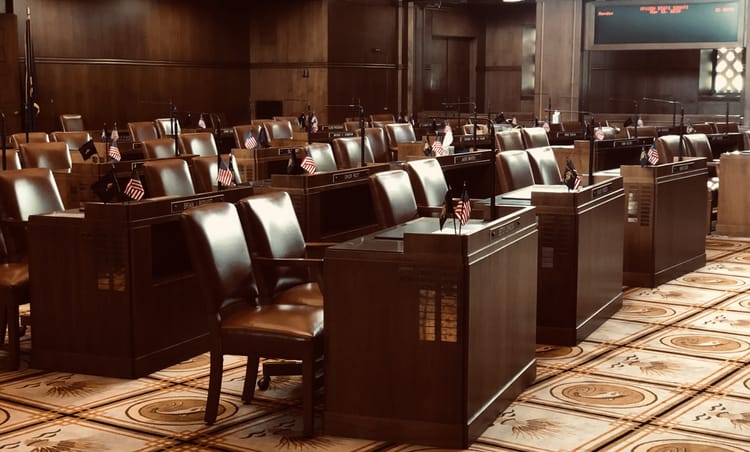Revenue Rebound Undercuts Calls for Tax Changes

Oregon’s budget is often a sideshow during the legislative interim. Lawmakers do most of the budget-writing during the long session and then rebalance in the short session, leaving the interim period for grant approvals and updates on specific agency initiatives. That conventional wisdom was flipped on its head this week as the state budget became the prominent legislative story.
After the September revenue forecast projected a $373 million deficit, the Co-Chairs of the Ways & Means Committee asked every state agency to identify reductions of 2.5 and 5 percent without impacting staffing levels. Fiscal analysts and administrators spent the fall sorting through options, such as leaving positions vacant, deferring equipment purchases, delaying grants, and holding back on office supplies for a workforce that already mostly works remotely. It was an exercise in restraint that, if nothing else, showed how easily agencies can find savings when asked to look.
By Wednesday, the foundation that had fueled weeks of belt-tightening and talk of tax increases was completely upended. In a presentation to a joint meeting of the legislative revenue committees, the Oregon Office of Economic Analysis announced the economic slowdown they had been tracking for more than a year appears to have reached an inflection point. After growing roughly six percent in real terms coming out of the pandemic, Oregon’s economy decelerated to 3.4 percent in 2023, 2.4 percent in 2024, and is expected to slow further to 1.6 percent this year. While the trend is certainly concerning, the economists now see signs of a rebound beginning in 2026.
Three factors are driving the shift in the economic narrative. First, federal tax cuts enacted through H.R. 1, the “One Big Beautiful Bill Act,” are providing a fiscal boost and, since some of those tax provisions are retroactive, are positioning businesses for new investments. Second, the effective tariff rate is proving far lower than the alarming levels announced earlier this year that had many private-sector economists predicting a recession. And third, the Federal Reserve is continuing to ease interest rates, with signals of another rate reduction in December or January and the likelihood of continued cuts through much of next year. Together, these policy levers are producing an economic inflection point in which the economy appears to be skipping a contraction and entering a slow rebound.
One area of particular weakness that forecasters are watching closely, however, is the state's labor market. Since 1980, Oregon has not had a year-over-year employment decline outside of a recession. The state's unemployment rate is higher than the average state and the national average, but forecasters are waiting to see if it is a momentary blip or a harbinger of things to come. In their written report, the economists acknowledge that August saw the largest monthly gain of jobs since 2022 (6,900), which could signal a turning point for unemployment in the state.

While the longer-term economic outlook is improving, the state revenue forecast upended the narrative that defined the interim hearings in the budget subcommittees. The December forecast increased General Fund revenues by $309.5 million, nearly erasing the September deficit. The state’s projected ending balance now stands at $63 million, a rounding error compared to where things stood just two months ago.
The biggest driver of the change is a surge in corporate tax payments, which are up $266.9 million since the last forecast. Those gains largely reflect amended returns and true-up payments from a handful of larger corporations from previous tax years. Notably, the economists said the increase should be viewed as one-time money, like quarters found under the couch cushions, rather than a broad-based expansion in business profits. Unlike typical forecast adjustments, however, this influx represents cash already in the state treasury — actual deposits rather than estimated collections — making it a genuine, albeit momentary, windfall.

The shifting revenue narrative could not come at a more crucial time. Some lawmakers have been floating ideas to “fix” the shortfall by decoupling Oregon’s tax code from federal tax law, effectively raising taxes. Specifically, these suggestions focus on recent changes to how federal tax law allows businesses to capitalize and depreciate certain expenses, such as new capital assets and research activities. While denying these policies would increase short-term revenues, it merely accelerates the state’s collection of revenues that would otherwise be paid in future years. It’s a classic budget gimmick, trading tomorrow’s stability for today’s convenience.
With the revenue deficit all but erased, the rationale for those proposals has evaporated. There is no fiscal need to decouple or raise new revenue — unless, of course, the ambition was always to increase revenue regardless of a crisis. Instead, this should be a moment to examine the drivers of the state’s revenue volatility and the reasons Oregon’s growth fundamentals have weakened more than those of other states. Oregon’s state tax competitiveness has dropped 28 places since 2019, following a surge in new taxes. The state also ranks fourth from the bottom in places to find a job. Oregon’s economic stumbles and revenue risks are self-induced. The coming short session will test whether lawmakers take the lesson to heart. The crisis they were preparing to solve has disappeared, but the structural challenges that created it remain.





